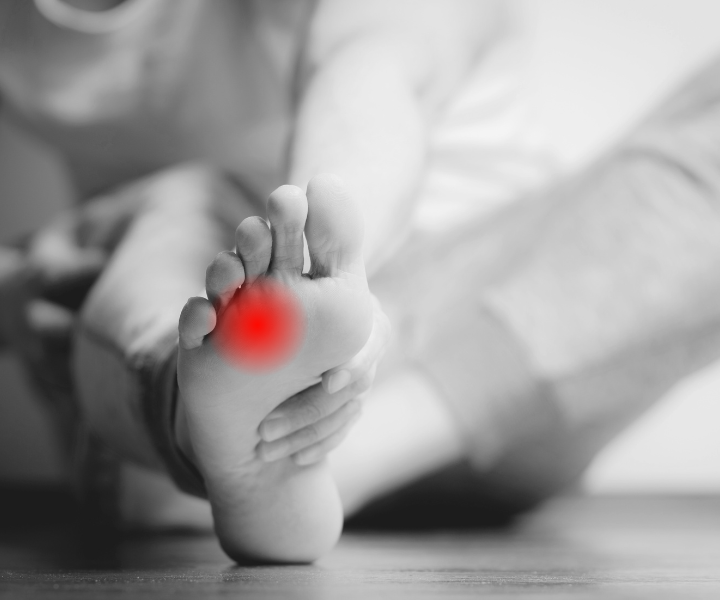Mortons neuroma is a nerve condition that affects the space between the toes, most commonly occurring between the third and fourth toes. It involves the thickening of the tissue around one of the nerves leading to the toes. This compression of the nerve causes pain, tingling, and discomfort in the ball of the foot.
Causes of Mortons Neuroma
The exact cause of Mortons neuroma is not always clear. However, several factors can contribute to its development, including:
- Footwear: Wearing tight, narrow-toed shoes or high heels can squeeze the toes together, compressing the nerves and leading to the development of a neuroma over time.
- Foot Structure and Biomechanics: Certain foot abnormalities, such as high arches, flat feet, or excessive pronation, can put increased pressure on the nerves in the ball of the foot, increasing the risk of developing Mortons neuroma.
- Repetitive Stress: Activities that involve repetitive stress on the forefoot, such as running or jumping, can irritate and inflame the nerves, potentially leading to the formation of a neuroma.
Symptoms of Mortons Neuroma
The symptoms of mortons neuroma may vary from person to person. Common signs and symptoms include:
- Sharp or Burning Pain: Individuals with mortons neuroma often experience a sharp or burning pain in the ball of the foot, typically between the third and fourth toes. The pain may radiate into the toes or back towards the arch of the foot.
- Tingling or Numbness: Some individuals may experience tingling or numbness in the affected area, leading to a sensation of pins and needles.
- Sensation of a Lump: Patients with mortons neuroma may feel as though they have a small pebble or lump in their shoe, even though there is nothing there. This sensation is due to the thickening of the nerve tissue.
How Can a Podiatrist Diagnose Mortons Neuroma
A podiatrist can diagnose Mortons neuroma through a thorough biomechanical assessment, which includes:
- Medical History Review: Your podiatrist will discuss your symptoms, medical history, and any factors that may have contributed to the development of mortons neuroma.
- Physical Examination: Your podiatrist will perform a physical examination of your foot, looking for signs of tenderness, swelling, or a palpable mass in the ball of the foot.
- Diagnostic Imaging: In some cases, your podiatrist may order diagnostic imaging tests, such as an X-ray or an MRI, to rule out other conditions and visualise the neuroma more clearly.
- Special Tests: Your podiatrist may perform specialised tests, such as a Mulder’s click test, to help confirm the presence of a neuroma. This involves squeezing the forefoot while palpating the area, which can elicit a clicking sensation.
How Can a Podiatrist Treat Mortons Neuroma
Once diagnosed, a podiatrist can recommend appropriate treatment options to manage mortons neuroma effectively. Some common treatment approaches include:
Footwear Modification: Switching to shoes with a wider toe box and lower heels can help alleviate pressure on the nerves and reduce symptoms. Shoes that provide ample room for the toes to move freely can be beneficial.
Orthotic Devices: Custom-made orthotic inserts can be prescribed to help support the arches, relieve pressure on the neuroma, and improve foot biomechanics. These devices can help distribute forces evenly and reduce discomfort.
Physical Therapy: Specific stretching and strengthening exercises can be prescribed by a podiatrist to help improve foot mechanics, relieve pressure on the nerve, and reduce symptoms.
Medications: Nonsteroidal anti-inflammatory drugs (NSAIDs) or corticosteroid injections may be recommended to reduce pain and inflammation associated with Morton’s neuroma. However, these medications should be used under the guidance of a healthcare professional.
Surgical Intervention: In severe cases where conservative treatments have failed to provide relief, surgical removal of the neuroma may be considered. A podiatrist can discuss the potential benefits and risks of surgery based on individual circumstances.
Mortons Neuroma Treatment and Prevention
In addition to treatment, certain preventive measures can help manage mortons neuroma and reduce the risk of its recurrence:
Wear Proper Footwear: Opt for shoes with a wide toe box and adequate arch support. Avoid tight, narrow shoes or high heels that can compress the toes and exacerbate symptoms.
Avoid Activities with Repetitive Impact: Minimise activities that involve repetitive stress on the forefoot, such as running or jumping, as they can aggravate the condition. Engaging in low-impact exercises can be beneficial.
Monitor Foot Biomechanics: Pay attention to foot posture and mechanics. Using orthotic devices or shoe inserts as recommended by a podiatrist can help maintain proper foot alignment and reduce excessive pressure on the nerves. Seeing your Podiatrist and maintaining regular appointments with them will be key to getting on top of any symptoms as early as possible.
Regular Foot Care: Maintain good foot hygiene and inspect your feet regularly for any signs of irritation or changes. Promptly address any foot discomfort or abnormalities to prevent complications.
Summary
Mortons neuroma can cause significant discomfort and affect an individual’s quality of life. By understanding the condition, recognizing its symptoms, and seeking timely professional care, individuals with Morton’s neuroma can find relief and regain their foot health.
If you suspect you have mortons neuroma or are experiencing related symptoms,
Come and visit us for Mortons Neuroma Treatment in Melbourne, please call 03 9878 4566 or email [email protected] and we can book you in for a Biomechanical Assessment in the closest clinic location that suits you; Blackburn, Melbourne CBD, Newport, Elsternwick, Caroline Springs or Springvale.

